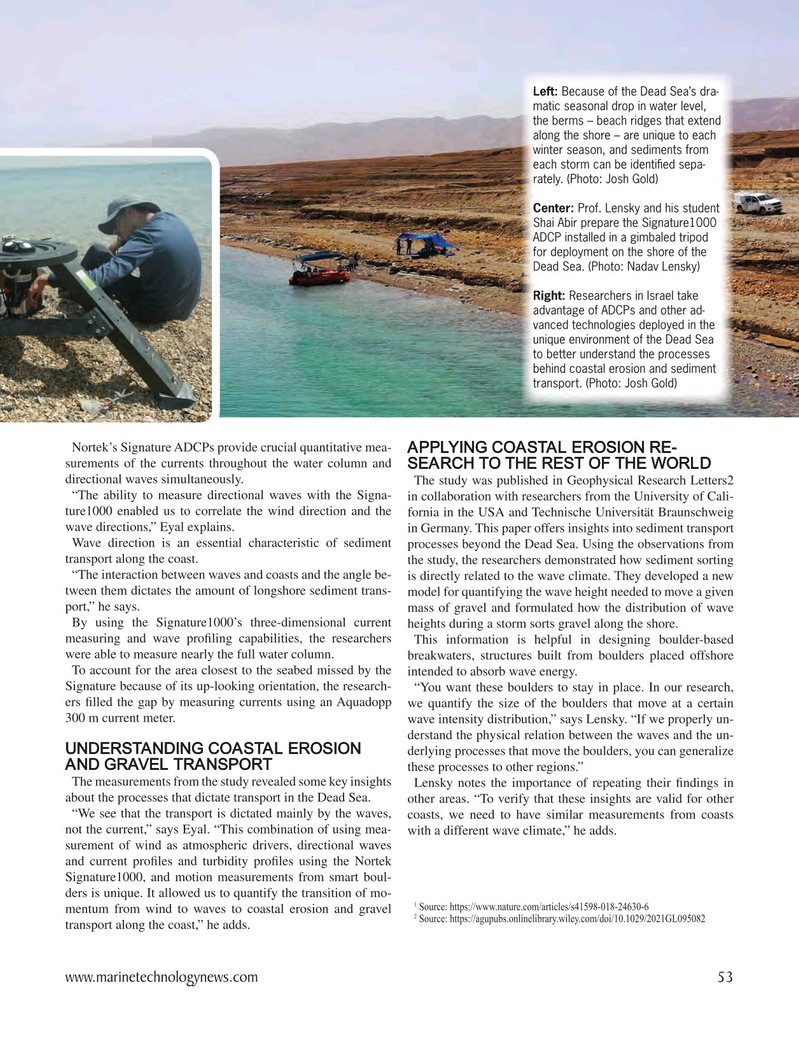
Page 53: of Marine Technology Magazine (March 2023)
Read this page in Pdf, Flash or Html5 edition of March 2023 Marine Technology Magazine
L L Left: Because of the Dead Sea’s dra- m matic seasonal drop in water level, t the berms – beach ridges that extend a along the shore – are unique to each w winter season, and sediments from e each storm can be identi? ed sepa- r rately. (Photo: Josh Gold)
C Center: Prof. Lensky and his student
S Shai Abir prepare the Signature1000
A ADCP installed in a gimbaled tripod f for deployment on the shore of the
D Dead Sea. (Photo: Nadav Lensky)
R Right: Researchers in Israel take a advantage of ADCPs and other ad- v vanced technologies deployed in the u unique environment of the Dead Sea t to better understand the processes b behind coastal erosion and sediment tr t t ansport. (Photo: Josh Gold)
Nortek’s Signature ADCPs provide crucial quantitative mea-
APPLYING COASTAL EROSION RE- surements of the currents throughout the water column and
SEARCH TO THE REST OF THE WORLD directional waves simultaneously. The study was published in Geophysical Research Letters2 “The ability to measure directional waves with the Signa- in collaboration with researchers from the University of Cali- ture1000 enabled us to correlate the wind direction and the fornia in the USA and Technische Universität Braunschweig wave directions,” Eyal explains. in Germany. This paper offers insights into sediment transport
Wave direction is an essential characteristic of sediment processes beyond the Dead Sea. Using the observations from transport along the coast. the study, the researchers demonstrated how sediment sorting “The interaction between waves and coasts and the angle be- is directly related to the wave climate. They developed a new tween them dictates the amount of longshore sediment trans- model for quantifying the wave height needed to move a given port,” he says. mass of gravel and formulated how the distribution of wave
By using the Signature1000’s three-dimensional current heights during a storm sorts gravel along the shore.
measuring and wave pro? ling capabilities, the researchers This information is helpful in designing boulder-based were able to measure nearly the full water column. breakwaters, structures built from boulders placed offshore
To account for the area closest to the seabed missed by the intended to absorb wave energy.
Signature because of its up-looking orientation, the research- “You want these boulders to stay in place. In our research, ers ? lled the gap by measuring currents using an Aquadopp we quantify the size of the boulders that move at a certain 300 m current meter. wave intensity distribution,” says Lensky. “If we properly un- derstand the physical relation between the waves and the un-
UNDERSTANDING COASTAL EROSION derlying processes that move the boulders, you can generalize
AND GRAVEL TRANSPORT these processes to other regions.”
The measurements from the study revealed some key insights Lensky notes the importance of repeating their ? ndings in about the processes that dictate transport in the Dead Sea. other areas. “To verify that these insights are valid for other “We see that the transport is dictated mainly by the waves, coasts, we need to have similar measurements from coasts not the current,” says Eyal. “This combination of using mea- with a different wave climate,” he adds.
surement of wind as atmospheric drivers, directional waves and current pro? les and turbidity pro? les using the Nortek
Signature1000, and motion measurements from smart boul- ders is unique. It allowed us to quantify the transition of mo- 1 Source: https://www.nature.com/articles/s41598-018-24630-6 mentum from wind to waves to coastal erosion and gravel 2 Source: https://agupubs.onlinelibrary.wiley.com/doi/10.1029/2021GL095082 transport along the coast,” he adds.
www.marinetechnologynews.com 53
MTR #3 (50-63).indd 53 3/20/2023 12:56:55 PM

 52
52

 54
54
